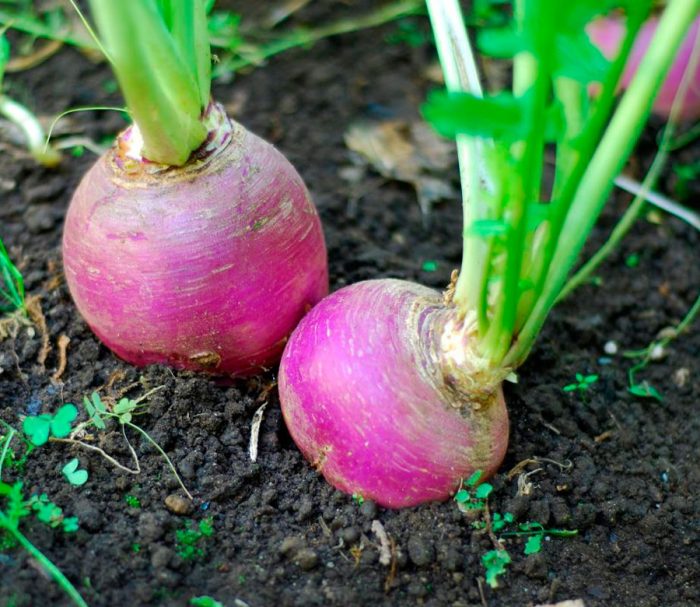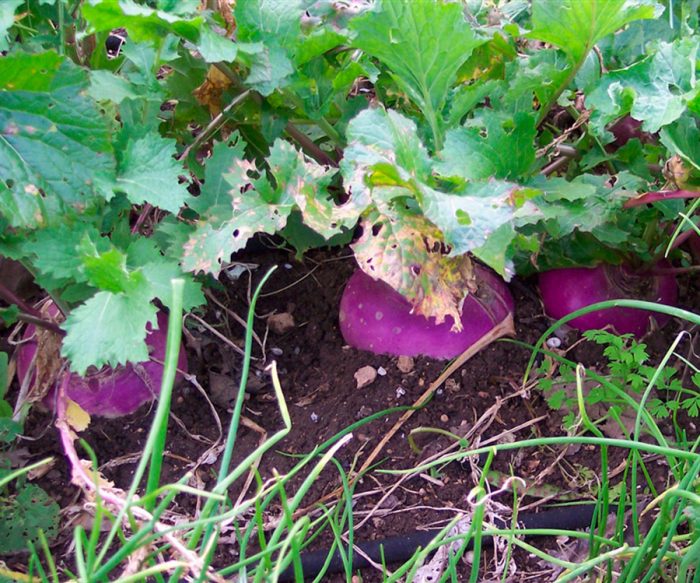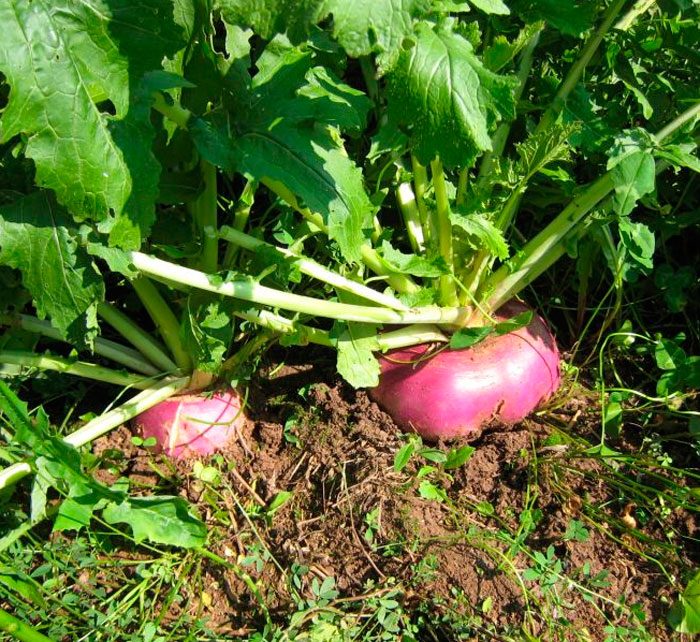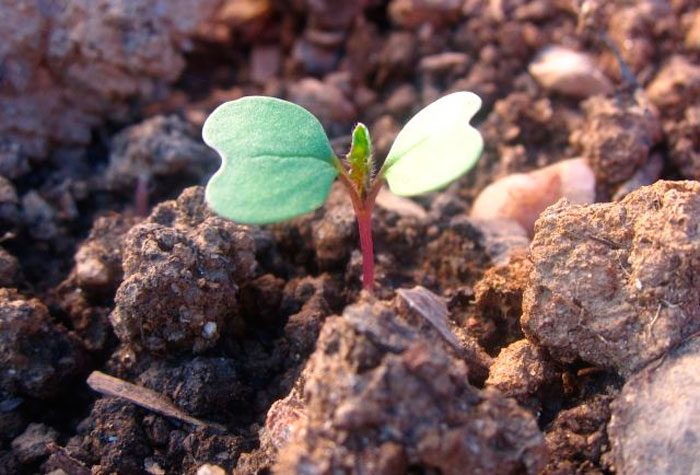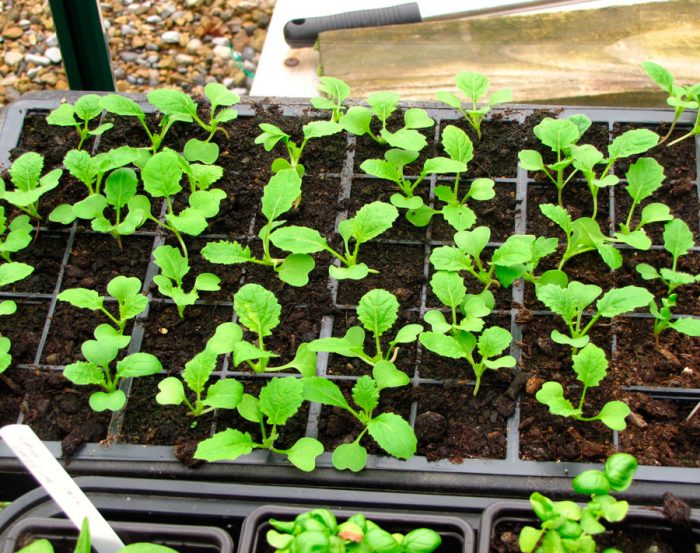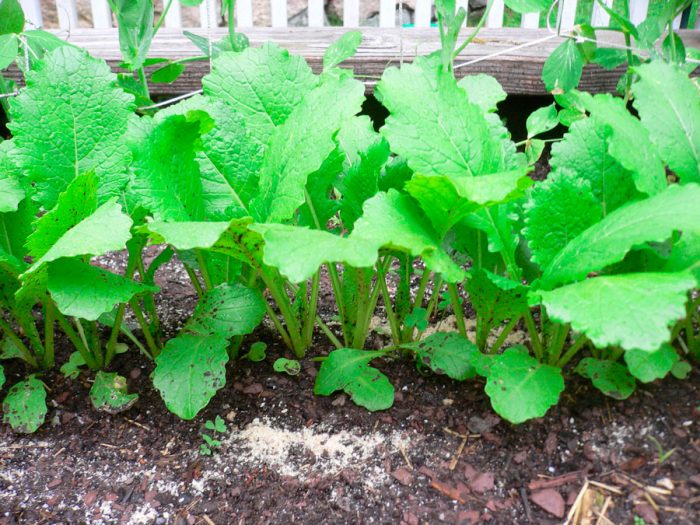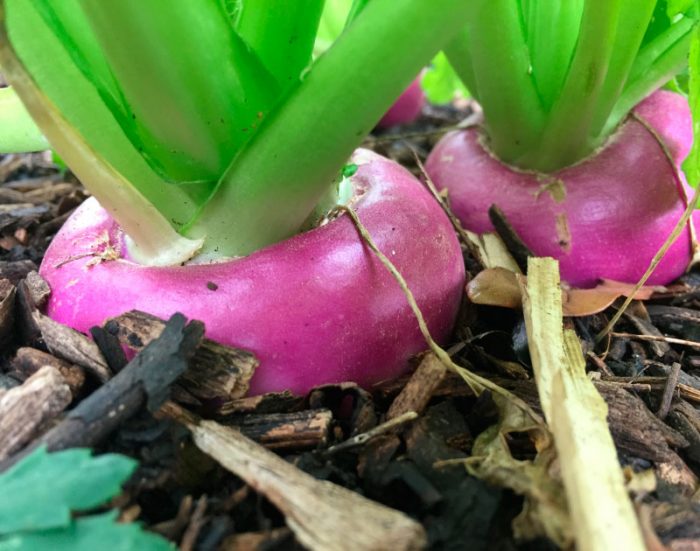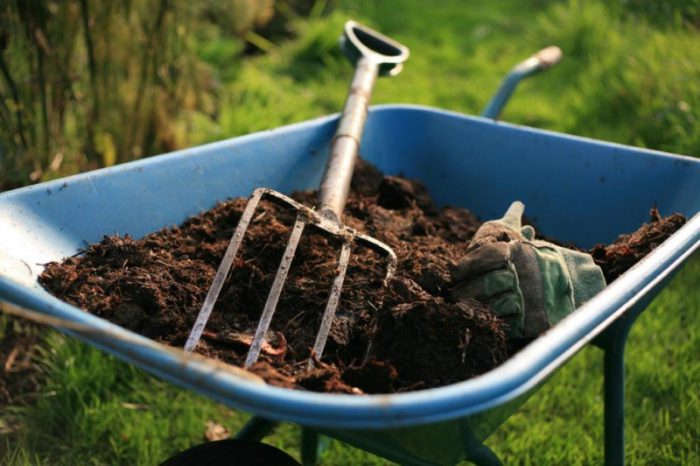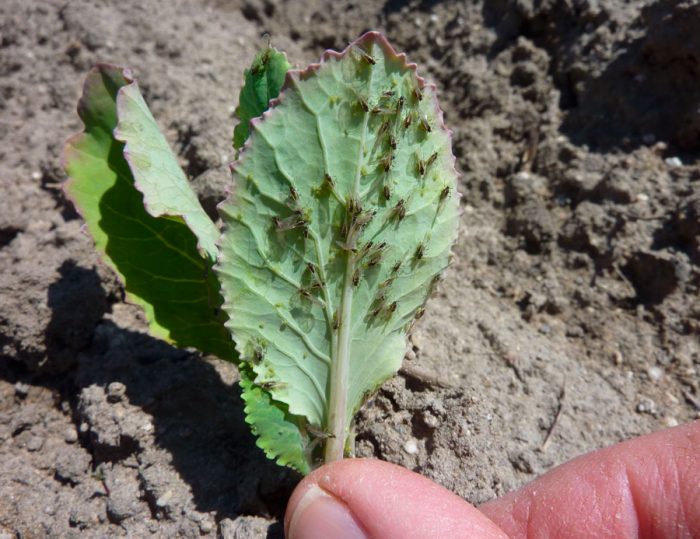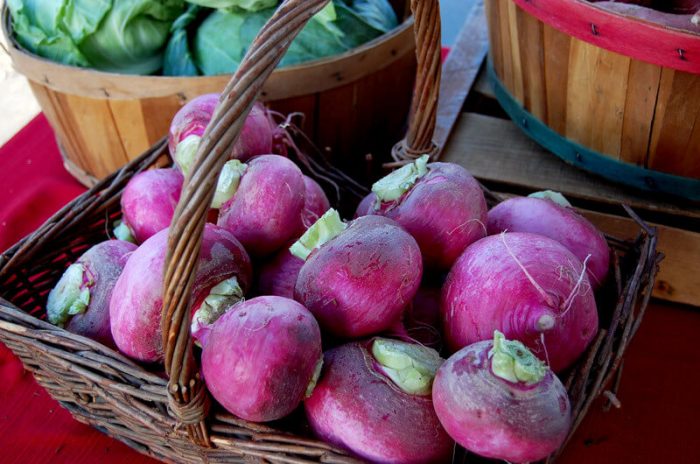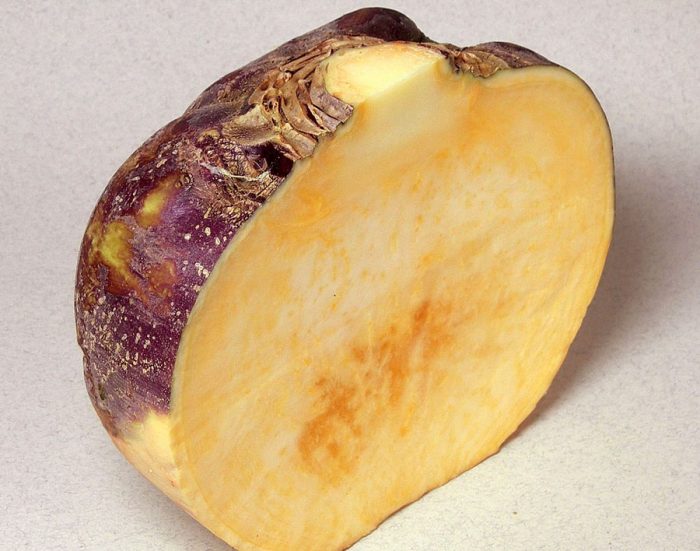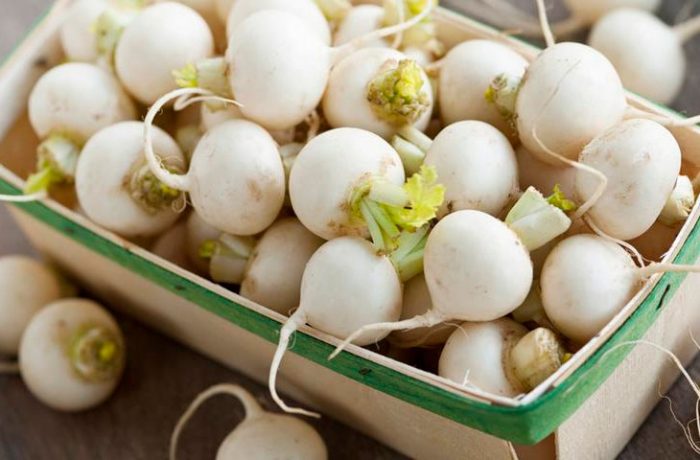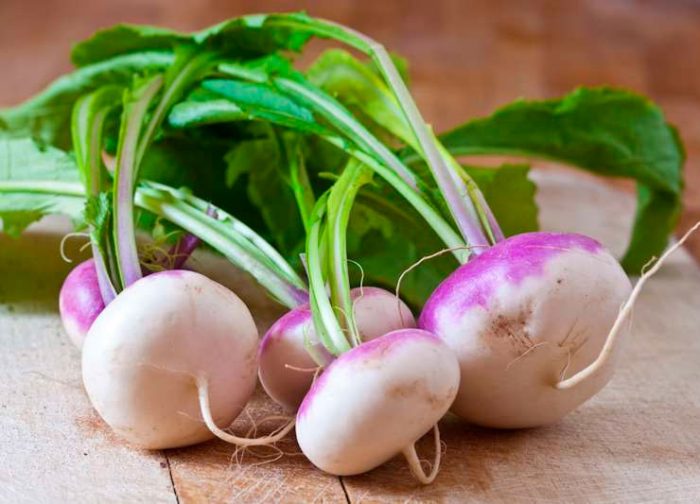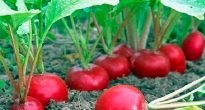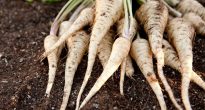The biennial vegetable culture of turnips (Brassica rapa subsp. Rapifera), also called forage turnips, is a member of the Cabbage or Cruciferous family. This plant is a type of rutabagus that does not occur naturally. This culture is most widely spread in Germany, USA, Denmark, Canada and Australia. Such a plant is cultivated on an industrial scale for feeding livestock. Already from the Bronze Age, the root crop of such a plant was used by Scandinavian tribes as a food product, which was valued in the same way as bread, only after the appearance of potatoes, this type of turnip began to be used more as a fodder crop. Turnip was cultivated already in the ancient world: in Rome, Egypt and Greece, and also on the territory of southern Europe and modern Afghanistan.
Content
Brief description of cultivation
- Sowing... For eating turnip in summer, it is sown in the last days of April, and for winter storage - in the first decade of July. Sowing seeds for seedlings is carried out in early April, while the plant is transplanted into open soil in the second half of May.
- Illumination... The site must be well lit.
- Priming... A sod-podzolic peat bog or loam with a pH of 5.0–6.5 is suitable for cultivation.
- Watering... It is necessary to water the bushes abundantly 1 or 2 times every 7 days, while for 1 square meter of the plot, from 5 to 6 liters of water is taken.
- Fertilizer... When grown on poor soil, the plant is fed twice during the season, for this they use a solution of mullein (1:10) or bird droppings (1:20). In June or July, the nutrient solution is mixed with superphosphate, it increases the sugar content of root crops.
- Reproduction... Generative (seed) way.
- Harmful insects... Spring cabbage and sprout flies, wavy and cruciferous fleas, cabbage moths, aphids, rape bugs and flower beetles.
- Diseases... Keela, leucorrhoea, mosaic, black leg and vascular bacteriosis.
Turnip features
During the first year of growth, turnips develop a root crop and a leaf rosette, while in the second year flowers and seeds appear in the bushes.In salad varieties, leaf plates are smooth, and in fodder they are sometimes pubescent. Root crops have a spherical, rounded-elongated, cylindrical and rounded shape, they can be painted white, pale yellow and purple, or any of these shades can be combined in one rhizome. The racemose inflorescences are yellow flowers, flowering begins in the second year of growth. The fruit is an elongated pod, inside of which are seeds of dark red or black color. Such a plant is considered a relative of the following crops: turnip, rutabaga, radish, radish, daikon, mustard, horseradish and all types of cabbage. Today there are a large number of table varieties of turnip.
Growing turnips from seeds
Sowing
It is quite easy to grow turnips on your site. In spring, seeds are sown in open soil in the last days of April or the first days of May, and in summer, in the first decade of July. Sowing turnip seeds for seedlings is carried out in early April. The seeds of such a plant are very small, therefore it is recommended to combine them with coarse-grained sand (1:10) before sowing. Sowing is carried out in peat pots, then the seeds are covered with a thin layer of sand, the thickness of which should be from 10 to 15 mm. Crops are moistened from a finely dispersed sprayer, while the containers are covered with a film or glass on top, and then they are removed to a warm place.
Growing turnip seedlings
When the seedlings appear, the most powerful of them should be left in the container, while the excess should be pinched off. It is not recommended to pull them out, as this can injure the root of a developed plant. It is necessary to care for the seedlings of such a culture in the same way as for seedlings of turnip, turnip or radish.
Seedling picking
All cruciferous root crops react extremely negatively to picking, in this regard, individual pots are used for sowing turnips, so that transplanting plants will be avoided.
Planting turnips in open ground
What time to plant
Turnip seedlings are transplanted into open soil after return frosts are left behind in spring. This time, as a rule, falls on the second half of May. In middle latitudes, planting of seedlings on the garden bed is carried out only after warm weather has established.
Turnip is a moisture-loving crop, therefore, for planting it, you must choose a well-lit or slightly shaded area located in the lowlands. Good predecessors of this crop are beets, strawberries, winter and spring cereals and annual herbaceous plants. On the site where representatives of the Cruciferous family were previously grown, no earlier than four years later.
Suitable soil
Soils such as sod-podzolic peat or loam are best suited for such a culture, while the pH should be from 5.0 to 6.5. Preparing the soil should be done in autumn, it must be dug to a depth of 20 to 25 centimeters, while 1.5 tbsp should be added to it. Nitrofoski or 1 tbsp. wood ash and 1/3 of a bucket of rotted manure per 1 square meter of land. You cannot add fresh manure to the soil, because because of this, the pulp of the root crop will lose its taste and become dark, while cracks will appear on the peel.
Open ground planting rules
Prepare the landing pits, while the distance between them should be from 20 to 30 centimeters, and the distance between the rows should be from 40 to 60 centimeters. Seedlings must be watered abundantly before planting. Then the plant, together with a lump of earth, is carefully removed from the container and placed in a previously prepared hole for planting. The hole must be filled with soil, then it is well tamped around the plants and watered abundantly. If peat pots were used to grow seedlings, then they are planted in open soil directly in them.After the liquid is completely absorbed into the ground, its surface must be covered with a layer of mulch (peat).
Winter landing
Before winter, turnip seeds are sometimes sown, but seedlings are not planted in the fall.
Turnip care
When growing turnips in open soil, they need to be looked after in the same way as for a turnip or turnip. Such a plant needs to provide systematic watering, weeding, fertilization and loosening of the soil surface.
The soil surface is loosened to a depth of 80 mm, while removing all weeds. This procedure is recommended after rain or watering. Before you loosen the surface of the garden for the first time, it is recommended to cover it with a layer of mustard or wood ash, this will scare off the cruciferous flea.
If the sowing of seeds was carried out directly into open soil, then after the seedlings develop 2 or 3 true leaf plates, they will need thinning.
Watering
For the cultivation of turnips in open soil to be successful, it must be watered in a timely manner, since due to the lack of the taste of the roots becomes bitter. If you water the bushes too much, then the roots will become watery. Watering such a crop should be abundant, while trying to make sure that the water does not erode the soil from the top of the root crop, because because of this, it begins to turn green, and its nutritional value is noticeably reduced. While the plants are young, when watering 1 square meter of the plot, from 5 to 6 liters are taken, and when roots begin to form, the amount of water is reduced to 3-4 liters of water. On average, turnips are watered 1 or 2 times every 7 days, but the number of waterings is strongly influenced by the weather.
Fertilizer
When grown on poor soil, such a plant should be fed 2 times a season, for this use organic fertilizer: a solution of slurry (1:10) or chicken droppings (1:20). At the same time, in June or July, superphosphate must be added to the nutrient solution, this will increase the sugar content of root crops. Such a culture responds well to additional feeding with copper, manganese and boron. The nutrient solution should be applied to moist soil, and when it is absorbed into the soil, its surface should be loosened. If the culture is grown in nutrient soil, into which all the necessary fertilizers have been applied, then there is no need to feed the turnip.
Turnip pests and diseases
Like all members of the cruciferous family, turnips can affect the following diseases: keela, leucorrhoea, mosaic, black leg and vascular bacteriosis. The greatest danger to such a culture is represented by the spring sprout and cabbage flies, as well as cruciferous and wavy fleas, cabbage aphids, moths and bedbugs, rape bugs and flower beetles. Signs of damage to turnip diseases are exactly the same as those of daikon, turnip, rutabaga and other representatives of the Cruciferous family.
Treatment
To cure the bushes from fungal diseases, they must be sprayed with a solution of a fungicidal drug: Quadris, Fundazol, Fitosporin or another agent with a similar effect. The bushes affected by the mosaic cannot be cured, so they must be removed from the ground and destroyed as soon as possible. To get rid of fleas, the bushes must be powdered with wood ash. At the same time, insecticidal preparations are used to destroy other insects, for example: Aktar, Aktellik, etc. However, so that harmful insects do not settle on the plants or that they are not affected by diseases, the rules of crop rotation and agricultural technology of this crop should be observed, as well as to provide them with proper care ...
Cleaning and storage of turnips
The duration of maturation of turnip from the moment of sowing the seeds is on average 24 weeks. When the root crop reaches technical maturity, the lower foliage of the bushes will turn yellow, wither and dry out. If the sowing of seeds was carried out in spring, then the harvest is carried out from the last days of June as it ripens.These root crops are not stored for a long time. Root crops that can be stored in winter, depending on the variety, are dug up in September or October. Remember that they should not freeze, because at a temperature of minus 6 degrees they become flabby, and they are stored much worse.
During harvesting, the bushes need to be pulled out or first dug up. It is necessary to remove soil residues from root crops and cut off the tops from them, while the length of the remaining segments should be approximately 20 mm. Vegetables should be laid out under a canopy to dry. You can only store healthy, whole and dry root crops, and they should also not be injured or affected by harmful insects or diseases.
To store turnips, you should choose a fairly cold room (from 0 to 2 degrees), while the air humidity should be from 85 to 90 percent, the roots should be laid out on a flooring made of boards. If desired, on the site, you can make a trench about 100 cm deep in the direction from south to north, the collected roots are placed in it, and then they are covered with peat or dry soil, and covered with a moisture-proof material on top.
Types and varieties of turnips
All varieties of turnips are divided into white meat and yellow meat. The composition of root crops with white pulp contains less dry matter compared to yellow-meat varieties, which, moreover, are distinguished by better keeping quality. However, varieties with white flesh are more productive.
The best yellow meat varieties
- Long Bortfeld... The tops of this variety are very poorly developed. Raised leaf plates are colored deep green. The yellow root vegetable has an elongated shape, it is submerged in the ground only ½ part. Pulling it out is quite difficult, since it has branched roots. Medium-juicy yellow pulp has a high taste.
- Finnish Bortfeld... The tops are colored deep green, while the petiole leaf plates are raised. The dark root crop is ½ part submerged in the ground, it is difficult to pull it out of the ground, since it has a large number of roots. Juicy and yellow pulp is distinguished by its high taste.
- Greyston... The bushes have an average amount of tops. Yellow or green raised leaf plates have yellow petioles. The rounded root crop is flattened on top, it is buried by ¼ part into the ground. The part that is located above the soil is pale green scaly, while the lower one is colored yellow. The roots of the root crop are few, in this regard, it can be very easily pulled out of the ground. The cultivar is a typical fodder turnip, its yellow flesh is not tasty and juicy.
- Yellow violet-headed... The tops of the bushes are underdeveloped. The color of the raised leaf plates is rich green, and their petioles are purple. The shape of the root crop is rounded-flattened, the upper part is dark purple, and the lower one is yellow. It is removed from the ground very easily. The faint yellow pulp is very tasty.
- Yellow Tankard... The tops of the bushes are highly developed, the half-raised leaf plates are colored green, like their petioles. The upper part of the elongated root vegetable is green, and the lower part is yellow, on its surface there are many roots. The root crop is buried in the ground by ½ part, in this regard, it is folded to pull it out. The dark and juicy pulp is quite tasty.
Popular varieties of turnip with white flesh
- Ostersundomsky (Estersundomsky)... The tops of the bushes are poorly developed, the half-raised leaf plates are painted green, and their petioles are purple. The upper part of the elongated root is purple and the lower part is white. It is buried in the ground by ½ part of its length, there are many roots on its surface, and therefore it is quite difficult to pull it out of the soil. The taste of the white pulp is medium with a slight bitterness.
- Six-week... The tops of the bushes are poorly developed, rich green raised leaf plates have greenish petioles. The slightly flattened rounded root vegetable has a white bottom and a pale green top. It is buried in the soil by ¼ part and has few roots, therefore it is very easy to pull it out of the soil. The juicy white pulp is distinguished by its high taste.
- Norfolk white round... In the bushes, the tops are highly developed, the semi-raised green leaf plates have purple petioles. The rounded root crop is flattened immediately above and below, it is purple, while its lower part is more intense in color. The root crop is buried in the ground only 1/5 part, therefore it is very easy to pull it out of the ground. Juicy and white pulp is quite tasty.
- Round redhead... The tops of the bushes are developed, the raised leaf plates have purple petioles. The shape of the root crops is rounded-flattened, while their upper part is dark purple, and the lower one is white. It is buried in the ground by 1/3 part, while it can be easily pulled out of the ground. Delicious pulp has medium juiciness.
- White ball... This variety appeared recently, the shape of the root crops is round, they are buried in the soil by ½ part. The top of the root vegetable is purple and the bottom is white. The juicy flesh is white in color.
Turnip properties: harm and benefit
Useful properties of turnips
The most important substances in the turnip root that have a positive effect on the human body are organic acids, essential oils and flavonoids. Such a vegetable is a dietary food product, it helps to cleanse the intestines of toxins, eliminate constipation, normalize metabolic processes, improve appetite and strengthen the immune system. Such a vegetable has an antibacterial effect, which has a beneficial effect on the intestinal microflora, the body gets rid of parasites, and the digestive processes are improved.
Turnip also has an anti-inflammatory effect, it is used in the treatment of the upper respiratory tract, diseases of the mouth and throat, for example, due to the expectorant effect, the lungs are cleared of mucus more quickly in bronchitis. The essential oils that make up the vegetable help to improve the functioning of the circulatory system and cleanse the blood from cholesterol, while the iron and copper contained in it saturate the blood with hemoglobin, preventing the development of anemia. And the root vegetable also helps to reduce blood sugar levels, which is the prevention of loss of elasticity and wear and tear of blood vessels, and also thanks to it, excess weight is lost. And the potassium compounds found in the turnip cleanse the body of excess fluid and sodium salts, and this has a beneficial effect on the condition of the bones, genitourinary system and heart. The root vegetable also contains phytocomponents, which are a prophylactic agent against cancer, they activate the antioxidant defense mechanism of the body.
Contraindications
This vegetable should not be included in their diet for people with exacerbation of diseases of the digestive tract, since it contains coarse fiber, which can cause severe irritation of the inflamed mucous membrane of internal organs.

